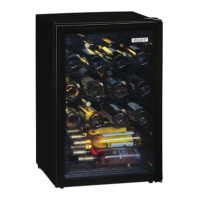The door is frequentl
opened or left open for If the dischar
e water outlet is clo
ed, or the
too lon
. defrost water drips over the channel, water will
The door is not properl
closed
the door ma
leak from the appliance.
sa
, the
asket ma
be polluted or dama
ed
.
.
Clean the clo
ed outlet.
Perhaps
ou ma
have overloaded the appliance.
.
Manuall
defrost the increased ice la
er
see
The reason ma
be inadequate ventilation of the ice Formation on the Inner rear Wall
.
compressor
assure adequate air circulation
.
Noise
Coolin
in this appliance is made possible b
coolin
the s
stem usin
a compressor, which
will produce certain noise levels. How nois
s lon
as the defrost water runs to the
the appliance is depends on where it is placed,
channel and throu
h the outlet to the drain
how it is used and how old the appliance is.
pan on the compressor, automatic defrostin
.
During the operation of the compressor
of the appliance is assured.
the noise of the liquid is heard and when the
In case the ice formation on the inner back compressor is not operatin
, the refri
erant flow
wall is increased
1/8-1/5in.
, ice should be is heard. This is a normal condition and it has
manuall
defrosted. no influence whatsoever on the lifetime of the
Set the thermostat knob to STOP
0
appliance.
position and leave the door open. Never .
fter starting the appliance, the
use electric devices for defrostin
and do operation of the compressor and the refri
erant
not scrape the ice or frost la
er with sharp flow ma
be louder, which does not mean that
ob
ects. somethin
is wron
with the appliance and it has
no influence on the lifetime of the appliance.
fter defrostin
is complete, turn the knob to Graduall
the noise will reduce.
desired position and close the door. The
.
Sometimes unusual and loude
noise
cause of increased ice formation ma
be ma
be heard. This noise is often a
one of the followin
: consequence of inadequate installation.
the door does not seal well
clean the
_
The appliance must be level and installed on
asket if it is contaminated, or replace it if a firm solid base/floor.
it is dama
ed
;
_
The appliance should not touch the wall or
the door is frequentl
opened or left too kitchen units standin
next to it.
lon
;
_
Check the accessories on the interior of the
the food stored in the appliance was warm; appliance, the
should be placed correctl
in
the food or dish is touchin
the inner back their positions; also check bottles, tins, and
wall. other vessels are not touchin
each other
causin
rattlin
and/or vibrations.
8
Continuous Operation of the
Cooling System
Ice Formation on the
Inner Rear Wall
Water is Leaking From the
Appliance

